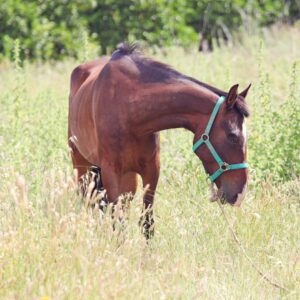 Cushing’s Disease in Horses and Importance of Diet: Pituitary pars intermedia dysfunction (PPID, equine Cushing’s disease) is an age-related endocrine disorder that occurs in about 20% of horses, ponies, and donkeys 15 years of age or older. PPID can occur in younger horses, but it is rare in those younger than 10 years of age. At this time, age is the only significant risk factor for PPID; no breed or sex predispositions have been determined.
Cushing’s Disease in Horses and Importance of Diet: Pituitary pars intermedia dysfunction (PPID, equine Cushing’s disease) is an age-related endocrine disorder that occurs in about 20% of horses, ponies, and donkeys 15 years of age or older. PPID can occur in younger horses, but it is rare in those younger than 10 years of age. At this time, age is the only significant risk factor for PPID; no breed or sex predispositions have been determined.
The pituitary gland, located at the base of the brain, has an important role in regulating body hormones. These hormones affect many metabolic and reproductive functions, blood pressure, and electrolyte balance. Horses with PPID develop enlargement and benign tumors in the pars intermedia, or the middle lobe, of the pituitary gland. This condition affects hormone production pathways in the brain, specifically from the hypothalamus and pituitary gland. The release of hormones from the pituitary gland is normally controlled through the neurotransmitter dopamine from the hypothalamus. In horses suffering from PPID, degeneration of the neurons that produce dopamine results in oversupply of hormones produced by the pars intermedia, and the subsequent high levels of these hormones can affect various body processes.
Approximately 30% of horses diagnosed with PPID also exhibit abnormal glucose metabolism (insulin dysregulation), in which blood insulin levels are high due to decreased insulin response in tissues. Insulin dysregulation places horses with PPID at higher risk of developing laminitis, which is one of the most serious complications of PPID. Insulin dysregulation is the defining characteristic of equine metabolic syndrome (EMS), and PPID and EMS can occur simultaneously in a horse. Horses with EMS may be at higher risk of developing PPID as they age, and at this time it is not known whether EMS and PPID are causatively linked.
Diagnosis:
The most common clinical signs of PPID include an abnormal haircoat (regional patches of long hair such as legs, chin, and belly), failure to shed (hypertrichosis), muscle loss, lethargy, chronic infections, weight loss (profound loss of fat and muscle), potbelly due to lost muscle tone, and abnormal sweating, either increased sweating (hyperhidrosis) or lack of sweating (anhidrosis).
Early diagnosis of PPID can be difficult. Blood tests are often negative in early stages of PPID, and symptoms can be overlooked in the normal aging process. Clinical signs of PPID may lead to a diagnosis based on examination and history. The long haircoat typical of PPID horses is often used as a diagnostic tool, but should not be used as an absolute diagnosis since malnutrition and other conditions can cause haircoat changes. Horses with mild PPID may be at risk of laminitis, so screening tests are important to help identify horses with PPID before overall health declines or laminitis develops.
Measurement of baseline ACTH is often used in diagnosis of PPID. Horses with more advanced PPID often exhibit elevated levels of ACTH. So resting plasma ACTH concentration is typically measured and compared to a reference range. However, ACTH levels can be affected by season, stress, illness, exercise, and sometimes diet. Testing the horse in its home environment when healthy and not stressed will yield the best results. A baseline ACTH test is most helpful for detecting moderate to advanced cases of PPID but may not detect early stage PPID.
Additional Testing:
Additional testing, such as thyrotropin releasing hormone (TRH) stimulation test, may provide additional evidence of early stage PPID, or when ACTH testing is inconclusive. In this protocol, after a baseline ACTH sample is collected, TRH is administered intravenously and in 10 minutes an additional ACTH sample is collected. However, there can be substantial variability in the results.
Many PPID horses exhibit insulin dysregulation, and PPID and EMS can coexist. Therefore, testing for insulin dysregulation is also important when PPID is suspected.
Treatment:
PPID is a progressive condition. Unfortunately, there is no cure. Treatment is intended to address and reduce clinical signs of the disease. It must be continued for the life of the horse. The prognosis for horses diagnosed with PPID is variable and somewhat dependent on symptoms. Some horses respond to a low level of medication. Meanwhile others require a much higher level. Some horses respond well to management protocols and may not require medication to maintain quality of life.
The only medication licensed for treatment of PPID in horses is pergolide mesylate. Pergolide is a drug that acts on receptors within the pars intermedia to suppress tissue enlargement and tumor growth. Amount of pergolide that results in improvement of clinical signs can vary. Horses that do not respond to high doses of pergolide may be treated with additional medication as prescribed by the veterinarian. Ongoing monitoring of horses undergoing treatment is important. It is recommended that retesting be performed at least twice a year to determine if changes in medication are needed.
Diet and exercise can help manage some symptoms of PPID but is not a cure. The horse’s body weight and condition, ability to exercise, and presence of insulin dysregulation will influence management recommendations. Further, the horse’s age will affect dietary requirements. PPID is a disease of aged horses. In many cases the horse’s dental condition will determine appropriate dietary changes. Is the horse is suffering from poor dentition (missing teeth, lack of chewing surface for utilization of long-stemmed forages?) A ration that provides forage alternatives such as pelleted forages or a formulated senior feed with adequate fiber to replace hay and pasture may be required to help support the older horse’s needs.
Dietary Management:
There are no specific dietary guidelines for PPID horses because symptoms vary. Not all PPID horses are prone to laminitis. So that must be taken into consideration. Some PPID horses are hard keepers and some are easy keepers. It is important to feed appropriate calories to maintain body weight and condition. If the horse is at risk of laminitis, maintaining appropriate body weight is essential. Ensure that excess weight is not putting strain on compromised hooves.
Further, providing a diet with controlled soluble carbohydrates to avoid blood glucose/insulin response that may increase risk of laminitis is an important part of dietary management. Is the horse is a hard keeper and at risk of laminitis? Ahigher calorie diet is recommended, but soluble carbohydrate levels are still of concern. Higher fat content to replace some soluble carbohydrates in the diet may be helpful in providing calories to support body weight and condition without increasing risk of laminitis.
If the PPID horse is not exhibiting insulin dysregulation, soluble carbohydrate content of the diet is not as much of a concern. As the disease progresses, though, it is important to monitor this and make changes if necessary.
Adequate high-quality protein in the diet of PPID horses may help reduce muscle wasting. In addition, it may support muscle maintenance and repair. Appropriate vitamin and mineral supplementation is also vital to support the aging horse’s nutrient requirements and potentially compromised immune function. Many supplements are marketed to specifically address the needs of PPID horses. However, at this time there is little published data to support specific ingredients or additives to address the symptoms of PPID.
Resources:
In conclusion, do you have questions about Cushing’s Disease in Horses and Importance of Diet? Contact us at J & J Hay Farms by clicking here!
Article Sources: Kentucky Equine Research
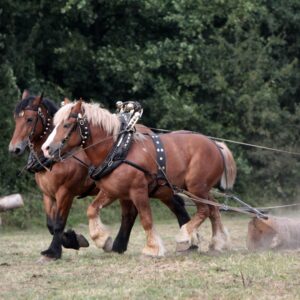 Letting Horses Do the Work: In addition to being ridden or driven for pleasure, many horses still work for a living. Some of these equines have jobs that do not immediately come to mind when considering horse-powered chores. A number of relatively ingenious methods have been created to convert the considerable strength of horses to augment human exertion.
Letting Horses Do the Work: In addition to being ridden or driven for pleasure, many horses still work for a living. Some of these equines have jobs that do not immediately come to mind when considering horse-powered chores. A number of relatively ingenious methods have been created to convert the considerable strength of horses to augment human exertion.
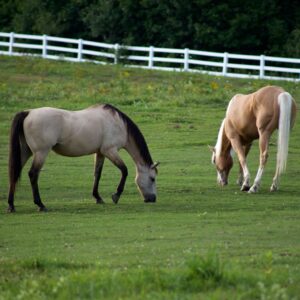 Feed Management Should Mimic Nature: By understanding the horse’s instinctive feeding behavior, today’s feeding strategies can be shaped to mimic natural tendencies. Certain feeding behaviors in horses are triggered by physiological changes and signals. Hormones, nerve signals, and homeostatic mechanisms lead to feelings of hunger. That hunger urges the horse to move around and look for something to eat. In a natural setting, the horse would wander about, lower its head, and graze while smelling and tasting various forages.
Feed Management Should Mimic Nature: By understanding the horse’s instinctive feeding behavior, today’s feeding strategies can be shaped to mimic natural tendencies. Certain feeding behaviors in horses are triggered by physiological changes and signals. Hormones, nerve signals, and homeostatic mechanisms lead to feelings of hunger. That hunger urges the horse to move around and look for something to eat. In a natural setting, the horse would wander about, lower its head, and graze while smelling and tasting various forages.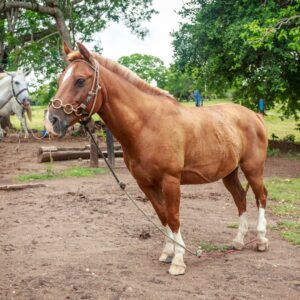 Restricting Forage Intake in Stubbornly Obese Horses: A medley of contributing factors can lead to obesity in horses. For example, overfeeding, sedentary lifestyle, genetics, and hormonal imbalances. Management of obesity involves evaluating every component of the diet and removing superfluous calories.
Restricting Forage Intake in Stubbornly Obese Horses: A medley of contributing factors can lead to obesity in horses. For example, overfeeding, sedentary lifestyle, genetics, and hormonal imbalances. Management of obesity involves evaluating every component of the diet and removing superfluous calories.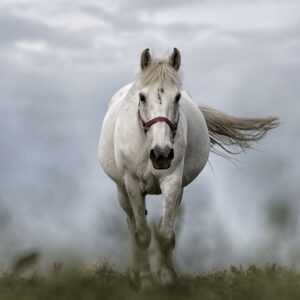 Feeding Horses Before Exercise: What to Feed and When? Three experiments were conducted to evaluate if feeding hay with and without grain affects glycemic response and hematological responses in Thoroughbred horses at rest and during a simulated competition exercise test on a high-speed treadmill. The first experiment evaluated how feeding forage along with grain influences plasma variables and water intake. The second experiment was conducted to determine whether these changes affect exercise performance. The third experiment was conducted to determine how forage alone affects exercise response.
Feeding Horses Before Exercise: What to Feed and When? Three experiments were conducted to evaluate if feeding hay with and without grain affects glycemic response and hematological responses in Thoroughbred horses at rest and during a simulated competition exercise test on a high-speed treadmill. The first experiment evaluated how feeding forage along with grain influences plasma variables and water intake. The second experiment was conducted to determine whether these changes affect exercise performance. The third experiment was conducted to determine how forage alone affects exercise response.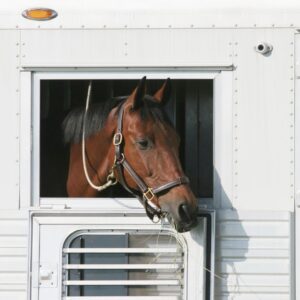 Considerations When Moving Horses to a Different Climate: Do you travel a lot? Then you know that you need to pack shorts for a Florida vacation. Mayne throw in an extra jacket for a winter visit to those New England cousins? Of course, stock up on antacid before you spend a few weeks with your great-aunt, an enthusiastic chef in Europe. In today’s equestrian world horses routinely move south for the winter training months. They fly to Germany for a dressage lesson. O Or possible, shuttle to the opposite hemisphere for a second breeding season. Therefore, owners need to think about ways to minimize stress. Here are tips to help equines make a smooth transition to another climate, a modified diet, and a different exercise routine.
Considerations When Moving Horses to a Different Climate: Do you travel a lot? Then you know that you need to pack shorts for a Florida vacation. Mayne throw in an extra jacket for a winter visit to those New England cousins? Of course, stock up on antacid before you spend a few weeks with your great-aunt, an enthusiastic chef in Europe. In today’s equestrian world horses routinely move south for the winter training months. They fly to Germany for a dressage lesson. O Or possible, shuttle to the opposite hemisphere for a second breeding season. Therefore, owners need to think about ways to minimize stress. Here are tips to help equines make a smooth transition to another climate, a modified diet, and a different exercise routine.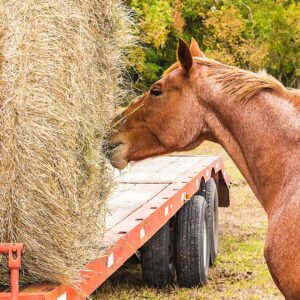 Long-Stem vs. Short-Stem Forages: Nutritionists recommend horses consume at least one to two pounds (0.5 to 1 kilograms) of long-stem forage each day. Long-stem forage is best defined as hay or pasture. This recommendation respects the natural desire of horses to graze. After all, they are hardwired to spend more than half of their day eating. Forage products that include extremely short pieces of fiber such as cubes, pellets, or chaff are often fed in lieu of long-stem forage. A spate of inquiries regarding the necessity of long-stem forage has landed in the electronic mailboxes of Kentucky Equine Research nutritionists. The overwhelming inquiry:
Long-Stem vs. Short-Stem Forages: Nutritionists recommend horses consume at least one to two pounds (0.5 to 1 kilograms) of long-stem forage each day. Long-stem forage is best defined as hay or pasture. This recommendation respects the natural desire of horses to graze. After all, they are hardwired to spend more than half of their day eating. Forage products that include extremely short pieces of fiber such as cubes, pellets, or chaff are often fed in lieu of long-stem forage. A spate of inquiries regarding the necessity of long-stem forage has landed in the electronic mailboxes of Kentucky Equine Research nutritionists. The overwhelming inquiry: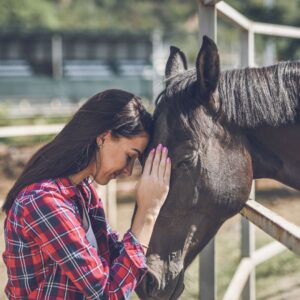 Dealing with Horses That Don’t Like What You’re Serving: Virtually all horses love to eat fresh green grass. Aside from that, each equine has its own dietary preferences. These vary from the chubby pony (happily gobbles anything and everything that’s offered) to the discerning older Thoroughbred mare who sniffs the expensive new nutritional supplement, turns away, and looks at you with a disdainful “this isn’t exactly what I had in mind” expression.
Dealing with Horses That Don’t Like What You’re Serving: Virtually all horses love to eat fresh green grass. Aside from that, each equine has its own dietary preferences. These vary from the chubby pony (happily gobbles anything and everything that’s offered) to the discerning older Thoroughbred mare who sniffs the expensive new nutritional supplement, turns away, and looks at you with a disdainful “this isn’t exactly what I had in mind” expression. Cushing’s Disease in Horses and Importance of Diet: Pituitary pars intermedia dysfunction (PPID, equine Cushing’s disease) is an age-related endocrine disorder that occurs in about 20% of horses, ponies, and donkeys 15 years of age or older. PPID can occur in younger horses, but it is rare in those younger than 10 years of age. At this time, age is the only significant risk factor for PPID; no breed or sex predispositions have been determined.
Cushing’s Disease in Horses and Importance of Diet: Pituitary pars intermedia dysfunction (PPID, equine Cushing’s disease) is an age-related endocrine disorder that occurs in about 20% of horses, ponies, and donkeys 15 years of age or older. PPID can occur in younger horses, but it is rare in those younger than 10 years of age. At this time, age is the only significant risk factor for PPID; no breed or sex predispositions have been determined.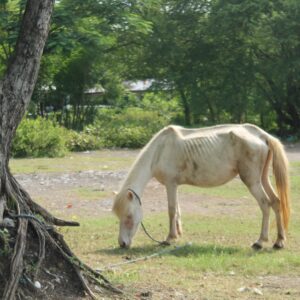 Proceed Carefully: Feeding Neglected Horses. For many horsemen and horsewomen, nothing proves more heartbreaking and maddening than seeing horses in neglectful situations. Especially when there’s little to eat or drink. Those that dedicate their time and resources to rehabilitating these horses know well the need to
Proceed Carefully: Feeding Neglected Horses. For many horsemen and horsewomen, nothing proves more heartbreaking and maddening than seeing horses in neglectful situations. Especially when there’s little to eat or drink. Those that dedicate their time and resources to rehabilitating these horses know well the need to 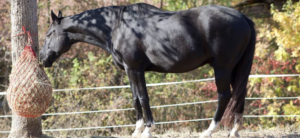 Pros and Cons of Using Haynets: New Information! For every good reason to manage a horse in a particular fashion there seems to be an equally compelling argument to not take that approach. Take haynets, for example. Haynets can be beneficial in some management scenarios. Yet a new study suggests they may increase a horse’s risk of neck or back injury.*
Pros and Cons of Using Haynets: New Information! For every good reason to manage a horse in a particular fashion there seems to be an equally compelling argument to not take that approach. Take haynets, for example. Haynets can be beneficial in some management scenarios. Yet a new study suggests they may increase a horse’s risk of neck or back injury.*